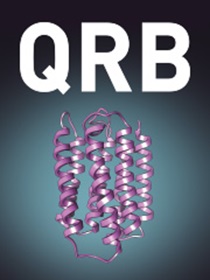淀粉样蛋白模型肽NACore的聚集行为
IF 5.3
2区 生物学
Q1 BIOPHYSICS
引用次数: 7
摘要
摘要利用低温透射电镜(cro - tem)、小角和广角x射线散射以及光谱学技术,研究了α-synuclein (68- gavvttgvtava -78) 11个残基长NACore肽段的聚集。水溶肽的溶解度依赖于pH值,当pH值从11.3降至约pH 8或6时,聚合被触发,此时肽的平均净电荷为弱负(pH 8),或基本为零(pH 6)。通过圆二色光谱和硫黄素T荧光,冷冻透射电镜显示在两种pH值下都存在长而坚硬的纤维聚集体,这些聚集体是由β-片建立起来的。原纤维是结晶的,具有广角x射线衍射模式,与先前确定的NACore晶体结构一致。特别值得注意的是,低温透射电镜观察到,在pH值为6时,小的球状聚集体被吸附在已经形成的原纤维表面上,其大小约为几纳米。纤颤动力学是缓慢的,发生在天的时间尺度上。同样,在两种pH下观察到缓慢的动力学,但在pH 6时稍微慢一些,尽管在这里肽的溶解度预计会更低。小球状聚集体的观察,以及相关的动力学,可能与淀粉样蛋白系统中二级成核和低聚物形成的机制高度相关。本文章由计算机程序翻译,如有差异,请以英文原文为准。
Aggregation behavior of the amyloid model peptide NACore
Abstract The aggregation of the 11 residue long NACore peptide segment of α-synuclein (68-GAVVTGVTAVA-78) has been investigated using a combination of cryogenic transmission electron microscopy (cryo-TEM), small- and wide-angle X-ray scattering, and spectroscopy techniques. The aqueous peptide solubility is pH dependent, and aggregation was triggered by a pH quench from pH 11.3 to approximately pH 8 or 6, where the average peptide net charge is weakly negative (pH 8), or essentially zero (pH 6). Cryo-TEM shows the presence of long and stiff fibrillar aggregates at both pH, that are built up from β-sheets, as demonstrated by circular dichroism spectroscopy and thioflavin T fluorescence. The fibrils are crystalline, with a wide angle X-ray diffraction pattern that is consistent with a previously determined crystal structure of NACore. Of particular note is the cryo-TEM observation of small globular shaped aggregates, of the order of a few nanometers in size, adsorbed onto the surface of already formed fibrils at pH 6. The fibrillation kinetics is slow, and occurs on the time scale of days. Similarly slow kinetics is observed at both pH, but slightly slower at pH 6, even though the peptide solubility is here expected to be lower. The observation of the small globular shaped aggregates, together with the associated kinetics, could be highly relevant in relation to mechanisms of secondary nucleation and oligomer formation in amyloid systems.
求助全文
通过发布文献求助,成功后即可免费获取论文全文。
去求助
来源期刊

Quarterly Reviews of Biophysics
生物-生物物理
CiteScore
12.90
自引率
1.60%
发文量
16
期刊介绍:
Quarterly Reviews of Biophysics covers the field of experimental and computational biophysics. Experimental biophysics span across different physics-based measurements such as optical microscopy, super-resolution imaging, electron microscopy, X-ray and neutron diffraction, spectroscopy, calorimetry, thermodynamics and their integrated uses. Computational biophysics includes theory, simulations, bioinformatics and system analysis. These biophysical methodologies are used to discover the structure, function and physiology of biological systems in varying complexities from cells, organelles, membranes, protein-nucleic acid complexes, molecular machines to molecules. The majority of reviews published are invited from authors who have made significant contributions to the field, who give critical, readable and sometimes controversial accounts of recent progress and problems in their specialty. The journal has long-standing, worldwide reputation, demonstrated by its high ranking in the ISI Science Citation Index, as a forum for general and specialized communication between biophysicists working in different areas. Thematic issues are occasionally published.
 求助内容:
求助内容: 应助结果提醒方式:
应助结果提醒方式:


